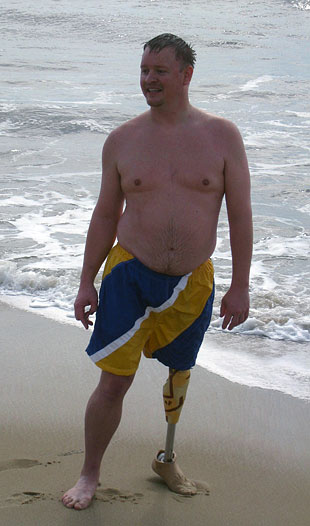Next-Generation Prosthetic Knee Passes Ocean Test

This summer in Ocean City, Md., an amputee working in a joint civilian-military research project took the new X3 microprocessor-controlled prosthetic knee for a test on the beach and into the Atlantic Ocean to bodyboard.
The Otto Bock HealthCare prosthetics technician joins more than 30 service members and older veterans at Walter Reed Army Medical Center in Washington, D.C., and Brooke Army Medical Center in San Antonio, Texas, who have been testing this line of prostheses since 2009.
The knee is being developed by Otto Bock HealthCare as part of the Military Amputee Research Program. The project is administered by the U.S. Army Medical Research and Materiel Command's Telemedicine and Advanced Technology Research Center at Fort Detrick, Md.
"While the DoD was already providing service members with the most advanced prosthetic devices available, those were proving insufficient for returning to a quality of life approaching what they experienced before their injury," said Troy Turner, TATRC Advanced Prosthetics and Human Performance portfolio manager.
He continued, "It was difficult at best for them to take up many activities they had enjoyed prior to their amputation'simple things like walking uphill, downhill, backwards, or even leaning against a wall.
"We saw that Otto Bock HealthCare wanted to move in directions our service members needed. After working with them on this for the past few years, what we saw demonstrated in Ocean City was huge. This is a game changer for a lot of people. It not only gives users more capabilities, but it's the first electronic leg they can use at the beach and ocean, the pool, or even in the mud for that matter."
The X3 is a ruggedized version of the X2, which gained national attention last December as the first prosthetic knee to enable users to run forward and backward and go up stairs and slopes foot over foot. It was heralded as an improvement over the C-Leg®, an advanced prosthetic also built by Otto Bock.
The X3 uses microprocessors, sensors, a gyroscope and an accelerometer to sense and control movement. "It automatically changes the flexibility and position of the knee so individuals can walk downhill, take stairs, bike, even body surf or boogie board in the ocean, without worrying about their prosthetic leg and whether it will keep them stable," said Turner.
The prosthesis can bear more weight than other models. Wearers report that it immediately and significantly reduces back, hip and knee pain because they do not have to rest their total body weight on the intact side of the body anymore. The X3 also has a longer battery life and is lighter and smaller than other options.
Noted Dr. Joseph Miller, who was present at the ocean trial, ""The beauty of this government collaboration is demonstrated through this advanced prosthetic device. It offers capabilities for all those with amputation, transcending the generations. It was truly amazing to be part of this innovative process and finally witness a product that sets the new standard." Miller is the national director of Orthotics and Prosthetics Services for the Veterans Health Administration.
The knees are currently being made available to military amputees, and it is expected that Otto Bock will be offering them to the civilian market sometime in 2011.














